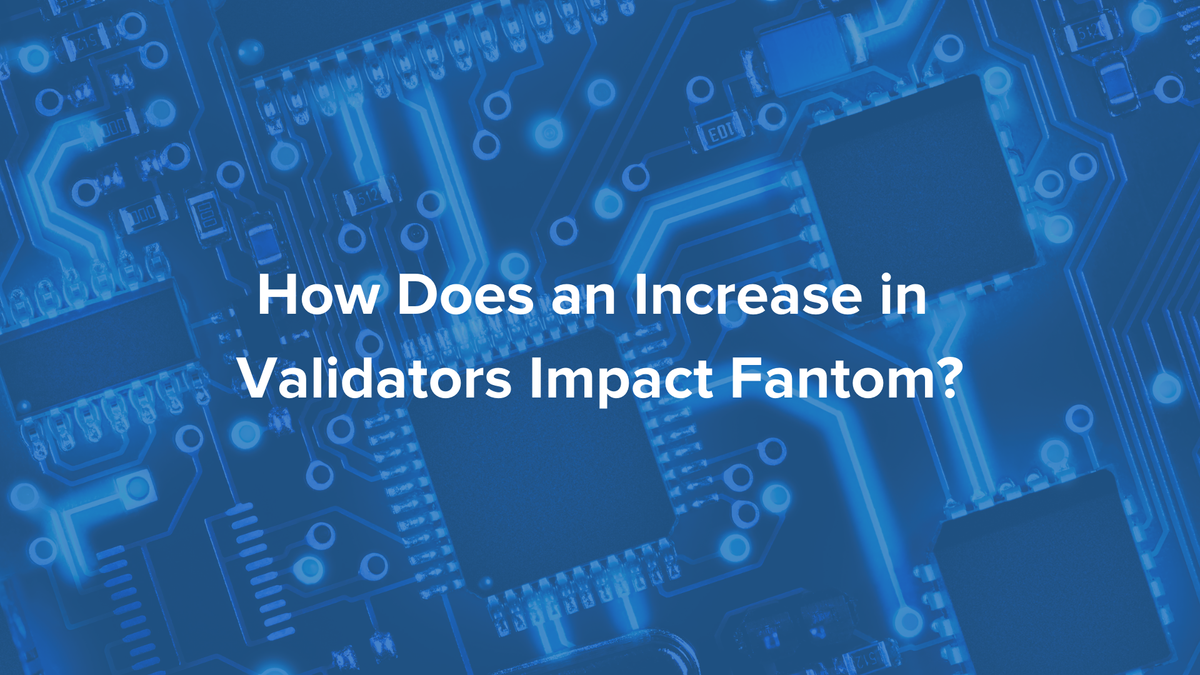How Does an Increase in Validators Impact Fantom?

A key priority for any decentralized network is to increase the number of validators running the network. By having more validators, a network makes it increasingly challenging for malicious actors to launch an attack.
In a decentralized system, the consensus is achieved through validators or miners sharing the state of the blockchain with each other, which includes agreeing on its state and any new transactions to include. Since the majority of validators must agree on a transaction for it to be finalized, a common concern is whether an increase in validators will slow down the network.
Currently, the Fantom community is voting on whether to reduce minimum validator staking requirements from 500,000 FTM to 50,000 – 100,000 FTM, which will lower the barriers to entry for running a validator.
In this article, we’ll explore how more validators might impact Fantom.
How do validators achieve consensus on Fantom?
First of all, we need to understand how Fantom achieves consensus. Fantom uses a proof-of-stake consensus mechanism called Lachesis. To understand fully how it works, read our article on How Consensus Works on Fantom. Otherwise, here’s a quick explanation.
Lachesis is an asynchronous consensus mechanism that validates and confirms transactions faster than traditional mechanisms. In this system, validators confirm transactions on their own and bundle these up in small batches to share with other validators, as opposed to all validators in the network working on confirming the same blocks, like in Bitcoin or Ethereum.
This process is asynchronous as the transaction batches shared between validators do not need to be sequential, which results in a more efficient process. As a transaction batch is propagated across the network, it is finalized into the Fantom blockchain shortly after two-thirds of validators in the network receive the batch and agree on its transactions.

Lachesis combines the speed and flexibility of allowing validators to confirm and batch their own transactions locally with the immutability of a blockchain that stores these finalized batches. It takes about 1-2 seconds from the moment a user submits a transaction until it’s finalized and included in the Fantom mainnet blockchain.
Will an increase in validators slow down Fantom?
As we learned above, with Fantom’s consensus mechanism, transactions must be received and agreed upon by two-thirds of the validators in the network before they’re finalized. By increasing validators on Fantom, two things will happen mainly:
- Transactions submitted by users will be propagated to a validator faster as there are more from which to choose. This can result in faster transaction batch emission.
- It may take more time for a batched transaction to reach two-thirds of the network to be finalized as there are more validators it needs to reach.
However, there are several reasons that we believe Fantom will not slow down due to more validators. As long as new validator nodes are running on quality nodes, the network will not see any downgrade in performance as it maintains the 1-2 seconds transaction finalization time.
Furthermore, we expect the existing large validators to continue representing the majority of the two-thirds of validators required for a transaction to be finalized as the network continues to mature. As such, it wouldn’t matter in terms of performance if hundreds of smaller nodes entered the Fantom network as the existing larger nodes would ensure the network stays fast and efficient.
Some might question how an increase in validators can decentralize Fantom further, given that the existing large validators still will be the ones to finalize the majority of transactions. The short answer is that we are positioning the network for the future.

When Fantom launched in 2019, its minimum staking requirement to run a validator was 3.175 million FTM. Since then, it has been lowered to 500,000 FTM gradually, which has allowed more validators to partake in running the network.
Although reducing the validator staking requirement on its own will not increase Fantom’s Nakamoto Coefficient, which is its level of architectural decentralization, it offers the opportunity for smaller validators to participate in the network. This will help to increase the Nakamoto Coefficient over time as these smaller validators grow in size gradually and become a vital part of Fantom in the future.
Will lower staking requirements be a security risk?
Lower staking requirements will not pose a security risk as the power given to validators to finalize transactions is proportional to their stake amount, and not the number of validators a given individual runs.
For example, a validator with 1 million FTM staked would have the same power as twenty smaller validators, each with 50,000 FTM staked. As such, an increase in the number of validators poses no security risk.

Some might argue that increasing the accessibility of running a validator also will make it easier for malicious actors to run validators. However, if the previous staking requirement were too high for a malicious attacker to run a validator, they don’t possess even a tiny fraction of the FTM needed to launch an attack.
Even if a malicious validator were to join the network and begin publishing false transactions, its stake would be slashed quickly as part of Fantom’s proof-of-stake security method. As such, there is no incentive to run a malicious validator in the first place.



